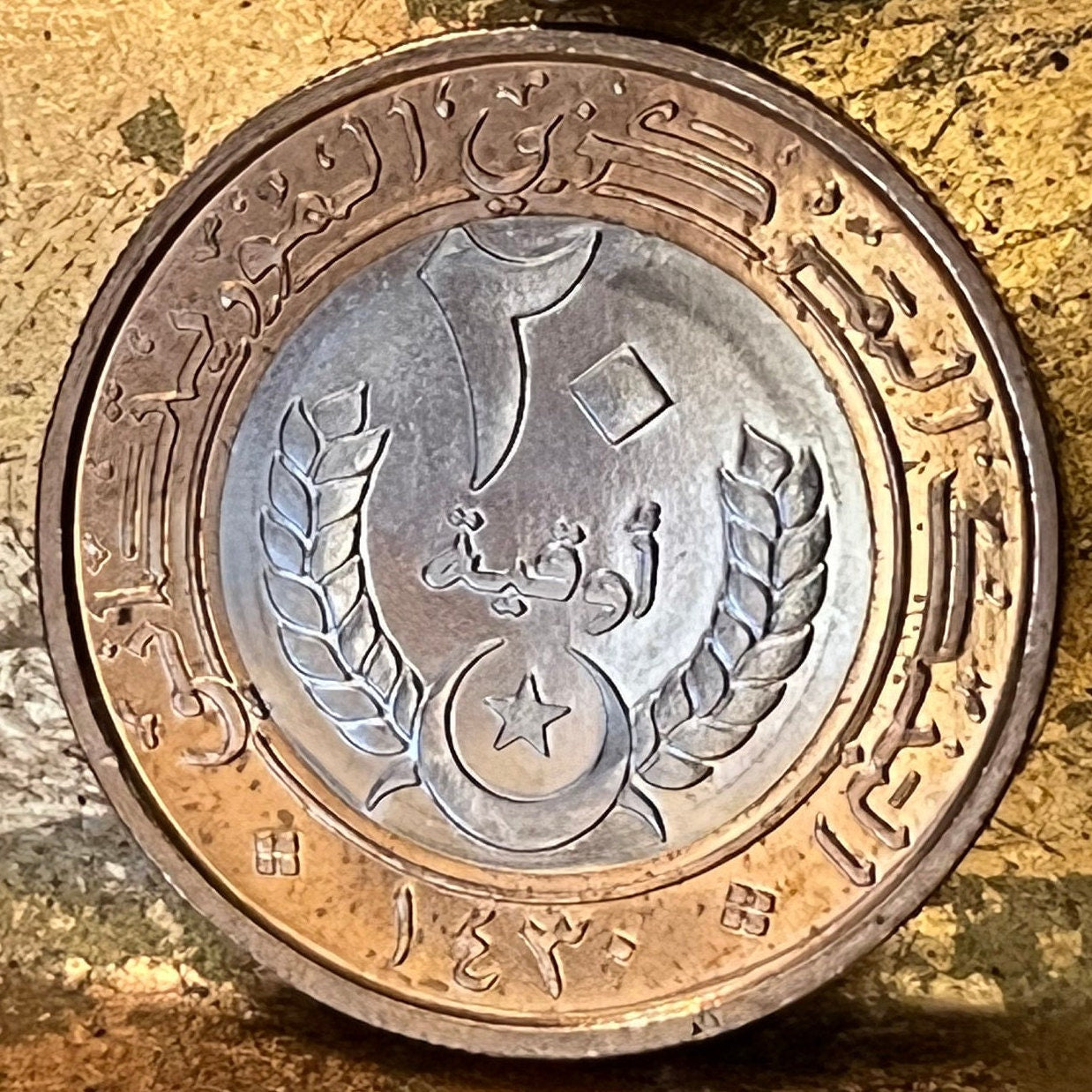elemintalshop
Crescent, Star, Palm Tree, Millet Branch 20 Ouguiya Mauritania Authentic Coin Money for Jewelry and Crafts (Bimetallic) (Islamic Republic)
Crescent, Star, Palm Tree, Millet Branch 20 Ouguiya Mauritania Authentic Coin Money for Jewelry and Crafts (Bimetallic) (Islamic Republic)
Couldn't load pickup availability
Crescent, Star, Palm Tree, Millet Branch 20 Ouguiya Mauritania Authentic Coin Money for Jewelry and Craft Making (Bimetallic) (Islamic Republic)
Obverse;
Top: Coat of Arms of Islamic Republic of Mauritania
Below: The denomination (20 Ouguiya) dividing the year (2009). Along the rim is the lettering of the Country's Central Bank (Banque Centrale De Mauritanie)
Lettering: 20 09
20 OUGUIYA
BANQUE CENTRALE DE MAURITANIE
Reverse:
Centre: Crescent & Star with Sprigs on either-side & below the denomination in Arabic (20 Ouguiya).
Outer Circle: Arabic lettering of the Country's Central Bank & the year in Islamic or Hijri calendar.
Lettering: البنك المركزي الموريتاني
٢٠
أوقية
١٤٣٠
Translation: The Central Bank of Mauritania
20 Ouguiya
1430
Edge: Alternate reeded and plain sections.
Features
Issuer Mauritania
Period Islamic Republic (1960-date)
Type Standard circulation coin
Years 1430-1435 (2009-2014)
Calendar Islamic (Hijri)
Value 20 Ouguiya
20 MRO = USD 0.05
Currency Old Ouguiya (1973-2018)
Composition Bimetallic: nickel plated steel centre in brass plated steel ring
Weight 6.9 g
Diameter 26 mm
Thickness 2.1 mm
Shape Round
Technique Milled
Orientation Coin alignment ↑↓
Number N# 12844
References KM# 8, Schön# 12
National Coat Of Arms Of Mauritania
Seal of Mauritania
The current national seal of Mauritania was adopted on August 15, 2017, to replace the green and gold seal adopted in 1959. The seal is an adaptation of the national flag and contains the gold, green, and red emblems. It is made up of two circles with gold edges. The inner circle is separated from the outer circle by a red field bearing the country's name: "Islamic Republic of Mauritania" in French (below) and Arabic (above). The inner circle contain crescent, star, palm tree, and millet branch.
Source: https://www.worldatlas.com/flags/mauritania
*************
Wikipedia:
In the later 20th century, the star and crescent have acquired a popular interpretation as a "symbol of Islam", occasionally embraced by Arab nationalism or Islamism in the 1970s to 1980s, but often rejected as erroneous or unfounded by Muslim commentators in more recent times.
*******
Wikipedia:
The star and crescent is an iconographic symbol used in various historical contexts, prominently as a symbol of the Ottoman Empire, with numerous modern countries still using it as a national symbol. It is also often it was developed at Kingdom of Pontus at Hellenistic period considered as a symbol of Islam by extension. It is the conjoined representation of a crescent and a star, both elements have a long prior history in the iconography of the Ancient Near East as representing either the Sun and Moon or the Moon and Morning Star (or their divine personifications). Coins with crescent and star symbols represented separately have a longer history, with possible ties to older Mesopotamian iconography. The star, or Sun, is often shown within the arc of the crescent (also called star in crescent, or star within crescent, for disambiguation of depictions of a star and a crescent side by side); In numismatics in particular, the term crescent and pellet is used in cases where the star is simplified to a single dot.
The combination is found comparatively rarely in late medieval and early modern heraldry. It rose to prominence with its adoption as the flag and national symbol of the Ottoman Empire and some of its administrative divisions (eyalets and vilayets) and later in the 19th-century Westernizing tanzimat (reforms). The Ottoman flag of 1844, with a white ay-yıldız (Turkish for "crescent-star") on a red background, continues to be in use as the flag of the Republic of Turkey, with minor modifications. Other states formerly part of the Ottoman Empire also used the symbol, including Libya (1951–1969 and after 2011), Tunisia (1831) and Algeria (1958). The same symbol was used in other national flags introduced during the 20th century, including the flags of Azerbaijan (1918), Pakistan (1947), Malaysia (1948), Singapore (1959), Mauritania (1959), Uzbekistan (1991), Turkmenistan (1991), Comoros (2001).
Share



















